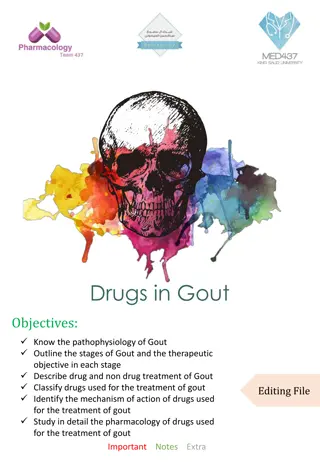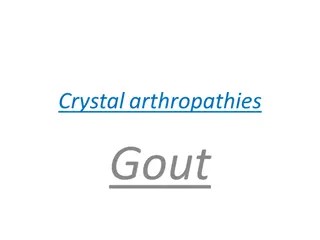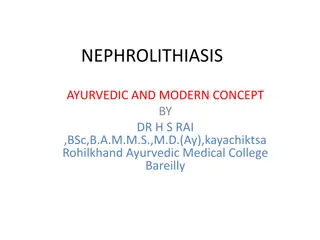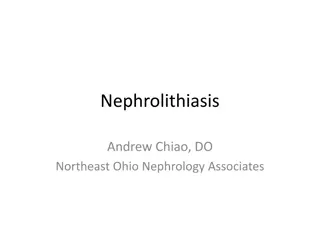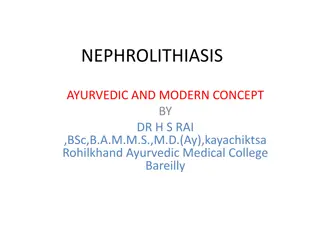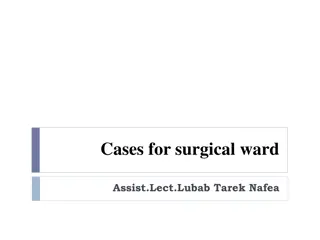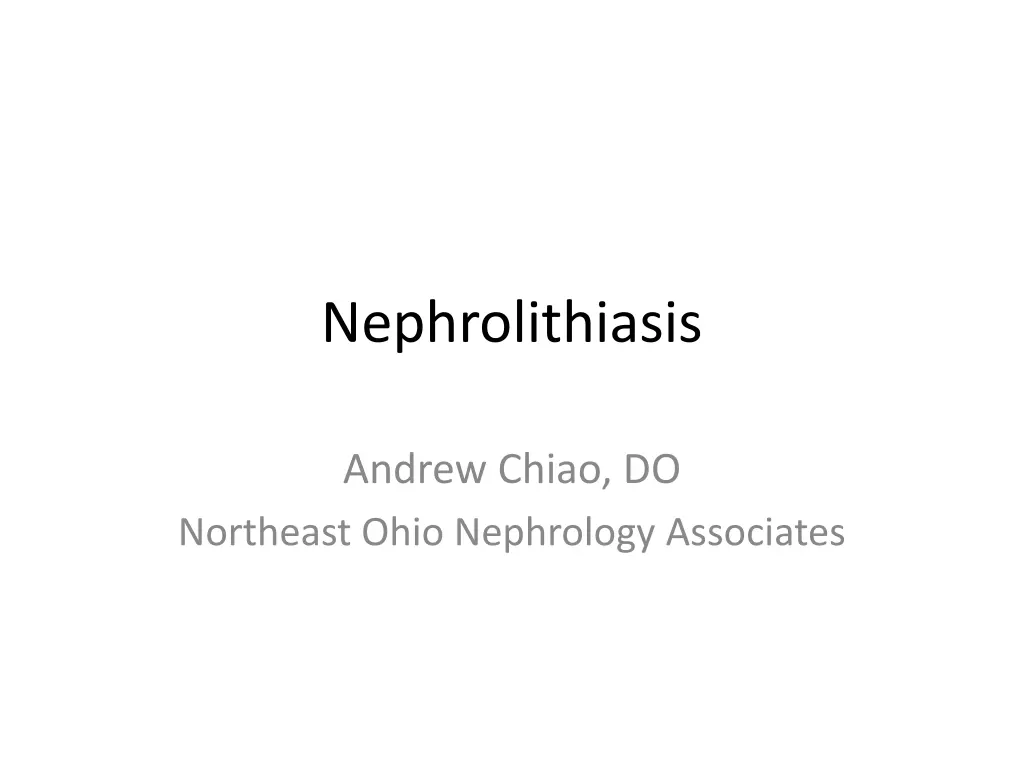
Understanding Nephrolithiasis: Risk Factors & Clinical Features
Nephrolithiasis, commonly known as kidney stones, is not just a urologic issue but can also lead to systemic complications like chronic kidney disease. This article discusses the epidemiology, associated features, risk factors, medications, and clinical features of nephrolithiasis. Learn about the incidence, prevalence, risk for recurrence, and common symptoms associated with this condition.
Download Presentation

Please find below an Image/Link to download the presentation.
The content on the website is provided AS IS for your information and personal use only. It may not be sold, licensed, or shared on other websites without obtaining consent from the author. If you encounter any issues during the download, it is possible that the publisher has removed the file from their server.
You are allowed to download the files provided on this website for personal or commercial use, subject to the condition that they are used lawfully. All files are the property of their respective owners.
The content on the website is provided AS IS for your information and personal use only. It may not be sold, licensed, or shared on other websites without obtaining consent from the author.
E N D
Presentation Transcript
Nephrolithiasis Andrew Chiao, DO Northeast Ohio Nephrology Associates
Introduction Not simply an isolated urologic disease Disorder with systemic complications Increased risk for chronic kidney disease Pfau et al, Am J Kidney Dis, 2016
Epidemiology Incidence 12% lifetime incidence Male predominance Relatively rare in African Americans Stone belt Wasserstein, Am J Kidney Dis, 2005
Stone Belt Brikowski et al, Proc Natl Acad Sci USA, 2008
Epidemiology Incidence Up to 16% of men and 8% of women will have at least one episode of symptomatic stones by age 70 years Over last 2 decades male to female ratio has changed from 3:1 to about 2:1 Presumably related to changes in lifestyle Pfau et al, Am J Kidney Dis, 2016
Epidemiology Prevalence 1 in 20 persons in 1994 1 in 11 persons in 2012 Risk for recurrence is high ~15% risk within 1 year ~50% risk at 5 years ~80% lifetime risk if untreated Wasserstein, Am J Kidney Dis, 2005 Pfau et al, Am J Kidney Dis, 2016
Associated Features & Risk Factors Obesity and hypertension Diet High animal protein intake Low fluid intake Low calcium intake High salt intake Hot climate or occupation Family history Medications Wasserstein, Am J Kidney Dis, 2005
Medications Crystallize in urine Atazanavir Indinavir Acyclovir Sulfadiazine Methotrexate Triamterene Quinolones Aminopenicillins Alter urine pH Topiramate Acetazolamide Pfau et al, Am J Kidney Dis, 2016
Clinical Features Renal colic Hematuria Not detected in >10% of cases Nausea Vomiting Dysuria Urinary urgency Pfau et al, Am J Kidney Dis, 2016
Clinical Features Outcome 90% of stones pass spontaneously Stones >5 mm are less likely to pass Urology assistance Wasserstein, Am J Kidney Dis, 2005
Imaging Studies Relative diagnostic sensitivities Computed tomography: near 100% Abdominal plain film: 60% to 65% Ultrasound: 10% to 25% Specific applications Computed tomography in acute renal colic Renal ultrasound in pregnancy & children Abdominal plain film to determine if stone is radiopaque and thus likely not uric acid Wasserstein, Am J Kidney Dis, 2005
Mechanisms of Stone Formation Pfau et al, Am J Kidney Dis, 2016
Mechanisms of Stone Formation Modes of stone growth Nucleation process by which free ions in solution associate into microscopic particles Growth movement of ions out of solution onto the growing crystal Aggregation agglomeration of large particles Wasserstein, Am J Kidney Dis, 2005
Mechanisms of Stone Formation Sites of stone growth Randall s plaques calcium phosphate deposits on external surface of papillae (nidus and anchor of calcium oxalate stones) Calcium oxalate receptors in collecting duct epithelium Wasserstein, Am J Kidney Dis, 2005
Mechanisms of Stone Formation Promoters Uric acid acts as nidus for calcium oxalate nucleation Alkaline urine pH favors calcium phosphate crystallization (RTA, primary hyperparathyroidism, milk alkali syndrome, carbonic anhydrase inhibitors) Acid urine pH favors uric acid precipitation and cystine precipitation Wasserstein, Am J Kidney Dis, 2005
Mechanisms of Stone Formation Inhibitors Alkaline urine pH inhibits cystine and uric acid stone formation Citrate Pyrophosphate Magnesium Proteins: Tamm-Horsfall protein, nephrocalcin, uropontin, glycosaminoglycans Wasserstein, Am J Kidney Dis, 2005
Mechanisms of Stone Formation Urine chemical risk factors for calcium stone formation Increased crystalloid concentration Low urine volume Hypercalciuria Hyperoxaluria Increased promoter concentration Hyperuricosuria Alkaline urine pH Reduced inhibitor concentration Hypocitraturia Wasserstein, Am J Kidney Dis, 2005
Calcium Nephrolithiasis Clinical features 75% to 90% of kidney stones Composition: calcium oxalate Monohydrate or dihydrate: correlation with duration of stone formation, resistance to shock-wave lithotripsy Typical calcium phosphate core Radiological appearance Characteristic calcium oxalate crystals (envelope) Typical stone passage rather than staghorn formation Wasserstein, Am J Kidney Dis, 2005
Urinary Risk Factors for Nephrolithiasis Low urine volume Sharply increased risk when urine volume <1 L/d Causes of low urine volume: Habitual or sociocultural low fluid intake Hot climate or occupation Gastrointestinal losses Urinary frequency (aversion to fluid intake) Wine, beer, coffee, and tea may have additional benefit Wasserstein, Am J Kidney Dis, 2005
Urinary Risk Factors for Nephrolithiasis Hypercalciuria Definitions Men, >300 mg/d Women, >250 mg/d Children, >4 mg/kg/d Incidence: about 50% of calcium stone formers Causes Primary hyperparathyroidism (5%), sarcoidosis, distal RTA, vitamin D intoxication, hyperthyroidism Rare genetic disorders: Dent s disease, autosomal dominant hypocalcemia Idiopathic (95%) Wasserstein, Am J Kidney Dis, 2005
Urinary Risk Factors for Nephrolithiasis Hyperoxaluria Incidence: 10% to 60% of stone formers May be more lithogenic than calcium Pathogenesis Increased intestinal absorption High-oxalate diet Low-calcium diet Enteric oxaluria (inflammatory bowel disease, intestinal bypass) Treatment: oral calcium supplements, low-oxalate diet, cholestyramine; reversal of intestinal bypass Increased production Primary hyperoxaluria Pyridoxine deficiency Vitamin C Wasserstein, Am J Kidney Dis, 2005
Urinary Risk Factors for Nephrolithiasis Hypocitraturia Incidence: 10% to 40% of calcium stone formers Causes Tubular reabsorption stimulated by intracellular acidosis Mechanisms Acidosis: renal insufficiency, chronic diarrheal states, high-protein diet, RTA Intracellular acidosis: potassium depletion Urinary tract infection: bacterial metabolism of citrate Idiopathic Treatment Alkali (bicarbonate or citrate); potassium preferred to sodium Neutralize daily acid load (1-2 mEq/kg/d); higher alkali requirement in RTA Wasserstein, Am J Kidney Dis, 2005
Urinary Risk Factors for Nephrolithiasis Hyperuricosuria Uric acid provides crystal lattice for calcium oxalate nucleation Usually due to dietary purine excess Treatment: allopurinol Wasserstein, Am J Kidney Dis, 2005
Metabolic Evaluation Pfau et al, Am J Kidney Dis, 2016
Recurrence of Kidney Stone Nomogram Pfau et al, Am J Kidney Dis, 2016
Recurrence of Kidney Stone Nomogram Pfau et al, Am J Kidney Dis, 2016
Reference Values for Lithogenic/Protective Substances in a 24-Hour Urine Sample Pfau et al, Am J Kidney Dis, 2016
Prevention of Calcium Nephrolithiasis Systematic high fluid intake Proven efficacy in single stone formers Goal: urine output of at least 2 L daily Benefit of specific beverages (wine, beer, coffee, tea, lemonade) Risk of certain beverages (grapefruit juice, possibly dark colas) Wasserstein, Am J Kidney Dis, 2005
Prevention of Calcium Nephrolithiasis Diet Moderate calcium intake Risks of calcium restriction: increased stone formation, osteopenia Salt and protein restriction (hypercalciuria) Low-oxalate diet (oxaluria) Low-purine diet (hyperuricosuria) Wasserstein, Am J Kidney Dis, 2005
Prevention of Calcium Nephrolithiasis Drugs of choice Thiazide diuretic (reduces urine calcium excretion) Indications: hypercalciuria, hypertension, osteopenia; benefit also in normocalciuric stone formers Concomitant salt restriction Adverse effect: hypocitraturia (potassium depletion) Potassium citrate Benefit in normocalciuric or normocitraturic stone formers as well as hypocitraturia Potassium supplement of choice during thiazide treatment or in mixed calcium uric acid nephrolithiasis Neutral phosphate: theoretical benefit in patients with activation of 1,25 dihydroxyvitamin D pathway Allopurinol: hyperuricosuric normocalciuric calcium stone formers Magnesium: theoretical benefit Wasserstein, Am J Kidney Dis, 2005
Medication Therapy Pfau et al, Am J Kidney Dis, 2016
References @SummerDashe. What a let down!!! My fianc and I got all excited because we got a package and thought it might be a wedding gift. He even helped me open it. It s a 24 hour urine test. A Litholink. To check my kidney function. https://twitter.com/summerdashe/status/1417628272 385478656. Posted July 20, 2021. Brikowski TH, Lotan Y, Pearle MS. Climate-related increase in the prevalence of urolithiasis in the United States. Proceedings of the National Academy of Sciences. 2008;105(28):9841-9846. doi:10.1073/pnas.0709652105
References Pfau A, Knauf F. Update on nephrolithiasis: Core curriculum 2016. American Journal of Kidney Diseases. 2016;68(6):973-985. doi:10.1053/j.ajkd.2016.05.016 Wasserstein AG. Nephrolithiasis. American Journal of Kidney Diseases. 2005;45(2):422-428. doi:10.1053/j.ajkd.2004.10.023 Yau, T., 2022. #KIDNEYcon 2018: Rocks Rock Little Rock. [online] AJKD Blog. Available at: <https://ajkdblog.org/2018/04/22/kidneycon-2018- rocks-rock-little-rock/> [Accessed 16 October 2022].

